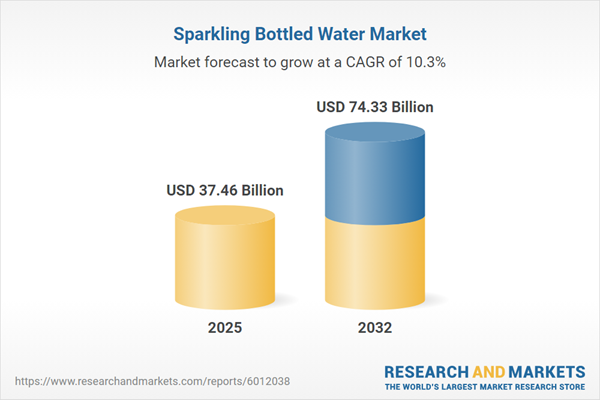Speak directly to the analyst to clarify any post sales queries you may have.
The sparkling bottled water market is evolving rapidly as shifting consumer preferences and industry innovation drive new standards for wellness, sustainability, and product differentiation. For industry leaders, staying ahead requires strategic clarity and a deep understanding of global trends affecting category dynamics and growth opportunities.
Market Snapshot: Sparkling Bottled Water Market
The global sparkling bottled water market grew from USD 33.92 billion in 2024 to USD 37.46 billion in 2025, and is projected to reach USD 74.33 billion by 2032 at a CAGR of 10.30%.
This growth reflects broad shifts in consumer values, business models, and regulatory environments shaping demand worldwide as the industry shifts toward premium experiences and eco-conscious solutions.Scope & Segmentation
Spanning mature and emerging regions, the study assesses market composition through a detailed lens, with actionable insights for supply chain executives, product strategists, and marketing leaders.
- Packaging Types: Cans (bulk, family, personal), glass bottles (bulk, family, personal), plastic bottles (bulk, family, personal)
- Flavors: Berry (mixed berry, raspberry, strawberry), citrus (lemon, lime, orange), unflavored options
- Volume Categories: Bulk, family, personal sizes
- Distribution Channels: Convenience stores, online retailers, specialty stores, supermarket and hypermarkets
- Price Tiers: Premium, standard, value offerings
- Geographic Coverage: Americas (North America: United States, Canada, Mexico; Latin America: Brazil, Argentina, Chile, Colombia, Peru), Europe, Middle East & Africa (Europe: United Kingdom, Germany, France, Russia, Italy, Spain, Netherlands, Sweden, Poland, Switzerland; Middle East: United Arab Emirates, Saudi Arabia, Qatar, Turkey, Israel; Africa: South Africa, Nigeria, Egypt, Kenya), Asia-Pacific (China, India, Japan, Australia, South Korea, Indonesia, Thailand, Malaysia, Singapore, Taiwan)
- Key Companies: The Coca-Cola Company, PepsiCo, Inc., Nestlé S.A., National Beverage Corp., Danone S.A., Suntory Beverage & Food Ltd., Talking Rain Beverage Company, Inc., Keurig Dr Pepper Inc., Asahi Group Holdings, Ltd., Primo Water Corporation
Key Takeaways for Decision-Makers
- Consumer demand is shaped by growing health consciousness, leading buyers to seek out brands with transparent sourcing, functional benefits, and natural ingredients across the sparkling bottled water category.
- Environmental priorities, including a strong push for recyclable and plant-based packaging, are motivating both multinationals and regional manufacturers to prioritize innovation in container formats and supply chain logistics.
- Flavor innovation and localized offerings are pivotal, as preferences differ by market—while botanical and berry infusions succeed in Asia-Pacific and North America, citrus flavors see strong adoption in Latin America and premium unflavored variants remain popular in hospitality.
- Premiumization intersects with sustainability and traceability, as consumers increasingly value product origin, water quality, and brand authenticity alongside environmental impact.
- Private label entrants from major retailers are intensifying competition, forcing established brands to rethink pricing, portfolio diversification, and channel management strategies.
- Digital commerce and influencer marketing accelerate the discovery of niche and artisanal sparkling water brands, aiding rapid market penetration and building direct customer relationships.
Tariff Impact
Recent adjustments to United States tariffs on input materials such as aluminum, glass, and PET have significantly altered sourcing economics. Brands are mitigating cost pressures through supplier diversification, nearshoring, and adjustments to inventory management. These shifts have also prompted investments in innovative packaging solutions and streamlined logistics to safeguard margins and preserve competitive positioning amid regulatory uncertainty.
Methodology & Data Sources
This report utilizes a multi-phased research approach, combining in-depth primary interviews with industry leaders, packaging experts, and distributors, alongside extensive secondary analysis of sector reports and regulatory filings. Quantitative inputs come from structured consumer surveys across diverse markets. Analytical frameworks such as SWOT, Porter’s Five Forces, and PESTEL were used to validate findings and ensure robust, actionable intelligence for stakeholders.
Why This Report Matters
- Provides strategic market segmentation and regional insights essential for refining product portfolios and optimizing distribution models as the sparkling bottled water market becomes increasingly competitive.
- Enables decision-makers to assess the impact of health trends, sustainability imperatives, and evolving trade regulations on market entry or expansion plans.
- Delivers authoritative benchmarking of leading brands and emerging competitors, supporting data-driven investment and partnership decisions in this dynamic sector.
Conclusion
The sparkling bottled water sector is characterized by dynamic shifts in consumer priorities, regulatory landscapes, and innovation. Leaders who embrace agile strategies, invest in sustainability, and align closely with regional trends will be well-positioned to capture ongoing opportunities and mitigate emerging risks across the global market.
Additional Product Information:
- Purchase of this report includes 1 year online access with quarterly updates.
- This report can be updated on request. Please contact our Customer Experience team using the Ask a Question widget on our website.
Table of Contents
3. Executive Summary
4. Market Overview
7. Cumulative Impact of Artificial Intelligence 2025
Companies Mentioned
The companies profiled in this Sparkling Bottled Water market report include:- The Coca-Cola Company
- PepsiCo, Inc.
- Nestlé S.A.
- National Beverage Corp.
- Danone S.A.
- Suntory Beverage & Food Ltd.
- Talking Rain Beverage Company, Inc.
- Keurig Dr Pepper Inc.
- Asahi Group Holdings, Ltd.
- Primo Water Corporation
Table Information
| Report Attribute | Details |
|---|---|
| No. of Pages | 194 |
| Published | October 2025 |
| Forecast Period | 2025 - 2032 |
| Estimated Market Value ( USD | $ 37.46 Billion |
| Forecasted Market Value ( USD | $ 74.33 Billion |
| Compound Annual Growth Rate | 10.3% |
| Regions Covered | Global |
| No. of Companies Mentioned | 11 |









